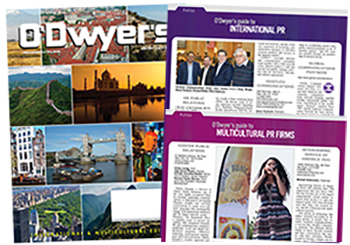|
|
Websites, social channels, display ads, press releases. While the definition of public relations — which Merriam Webster defines as “the business of inducing the public to have understanding for and goodwill toward a person, firm, or institution” — has not changed, the ways in which we reach, engage and influence audiences continue to evolve on a daily basis. Particularly in the healthcare sector, where the stakes — improving health outcomes — are highest, it’s imperative to stay current and push boundaries in order to communicate most effectively.
|
|
Gone are the days when content was developed simply for distribution. Now it must ladder up to a holistic communications plan in order to ensure meaningful engagement. To be impactful, it must be customized for each channel and audience.
Securing favorable media coverage in target outlets is no longer the goal of PR programs, but the starting point of a broader amplification process that integrates earned media into the world of paid, owned and social, exposing more people to messaging that changes attitudes and behaviors.
Where influence used to be centralized among a few opinion leaders or advocates, today a broad range of voices from around the world offer health advice across a plethora of platforms that are readily available at any time on our laptops, tablets and phones. Patients, even those with rare diseases, can now easily connect with others who also suffer from their condition, sharing experiences in an effort to optimize outcomes.
Despite all of the change happening around us, one thing remains consistent. Healthcare PR professionals are still fighting to demonstrate return on investment in an increasingly fierce battle for funding. With the proliferation of digital agencies and the expanding service offerings of advertising agencies in this evolving communications landscape, it is critical that PR agencies are able to demonstrate the value of the conversations we drive and shape.
To do so, we must embrace a cataclysmal shift in the framework for measurement: moving from output to outcomes.
Outcomes-based measures go way beyond past industry-standard metrics, such as impressions or unique visitors. We’re now able to understand how audiences are engaging with the content we create and what they are doing after being exposed to it. Compared to outputs, outcomes-based metrics are harder to assess — they are dynamic and interconnected. That means we must have robust measurement in place — measurement that’s real-time and always on.
With proper analytics, we can optimize resources across paid, earned, social and owned properties based on detailed data to show how audiences interact with our content. This performance-based optimization will help us to better target our efforts across geographies and channels, leading to more exposure, engagement and — at the end of the day — improved outcomes for those whose health depends on the information we’re sharing.
GLOBALHealthPR leaders from around the world recently gathered in Mexico City for an annual meeting, where one of the key topics was measurement. Coming out of that meeting, I asked several of my colleagues to share their thoughts on measurement at the regional and local level.
Eugenia De La Fuente, Co-Owner of Buenos Aires-based Paradigma PEL Comunicación, the GLOBALHealthPR agency partner in Argentina, said that measurement cannot simply be an afterthought, but must be planned for from the moment a communications program is conceived and carried through every step of the way.
“The challenge nowadays in Latin America is that, despite most countries sharing the language of Spanish, the media landscape is very diverse by market,” De La Fuente said. “In combination with an often-fragmented approach to execution across countries, this makes it critical to establish a uniform methodology for measurements on a regional scale.”
GLOBALHealthPR’s APAC Executive Director, James Yi, noted that PR professionals across the Asia Pacific region also need to show a quantitative return in order to help educate internal stakeholders on what PR is and does.
“In APAC there’s a need to not only find and agree on new standards of measurement, but equally to educate marketers and PR professionals on the drastic evolution to more integrated communications,” said Yi.
Neil Crump, CEO and Owner of GLOBALHealthPR’s European Hub and UK agency partner, Aurora, said that clients wanting to use data to help demonstrate ROI is on the rise across Europe, with many leading brands calling for the use of data to help drive their future marketing efforts.
“Many don’t understand where this data comes from or then how to use it,” said Crump. “Our job is to help clients interpret and adopt a ‘data-driven’ approach to storytelling that can evolve based on audience-insights.”
Despite the unique considerations of each market, the need and desire for outcomes-based measurement is apparent across the globe, throughout the industry.
“While there is still some use of reach metrics in Latin America,” said De La Fuente, “we are seeing a quick evolution to more outcomes-based analytics that can help us understand the impact we’re having in real time, leading to better allocation of resources and more effective communications campaigns moving forward.”
Yi agrees that, as an industry, we need to be looking towards in-depth analyses of quantitative and qualitative data, including human interactions, to bridge the gap between PR and outcomes.
“It’s imperative to set and agree on objectives (both communications and business) and then fix measurement focal areas as factors of success,” said Yi. “In today’s integrated communications landscape, this will include a diverse range of measurement criteria that help us capture both perceptual and behavioral change.”
Crump believes that, due to the proliferation of new technologies, we are closer than ever to those we reach with our campaigns. “Entering this data-driven era makes this, on paper, one of the most exciting times to be in marketing communications,” said Crump.
As communicators, we now have the ability to harness technology and data to track and react to the evolution of conversations taking place across channels, all around the world, in real time. In doing, so we have the unique opportunity to elevate and amplify the conversations that are changing healthcare worldwide.
***
Tim Goddard is executive vice president of GLOBALHealthPR.

 Tim Goddard
Tim Goddard

 Lo Isidro, senior director at Real Chemistry with more than a decade of strategic communications and PA experience, has joined Narrative Strategies.
Lo Isidro, senior director at Real Chemistry with more than a decade of strategic communications and PA experience, has joined Narrative Strategies. Nelson Fernandez, former North American chair of APCO Worldwide and managing director of Burson-Marsteller, has joined Volunteers in Medicine Berkshires as director of communications and PA.
Nelson Fernandez, former North American chair of APCO Worldwide and managing director of Burson-Marsteller, has joined Volunteers in Medicine Berkshires as director of communications and PA. Lilit Bargar, who was most recently an EVP in the healthcare practice at Weber Shandwick, comes on board at GCI Health as EVP, corporate practice lead.
Lilit Bargar, who was most recently an EVP in the healthcare practice at Weber Shandwick, comes on board at GCI Health as EVP, corporate practice lead.
 Five ways that successful thought leaders are made.
Five ways that successful thought leaders are made.


 Have a comment? Send it to
Have a comment? Send it to 
No comments have been submitted for this story yet.